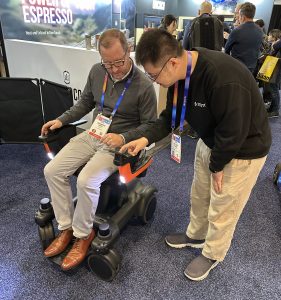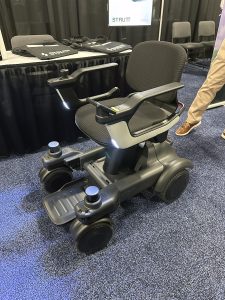Strutt’s ev1 Merges LiDAR Technology with Personal Mobility
By Andy Nemann
From lane departure assistance to forward-collision warning to blind spot warnings, modern cars offer technology that seems to do everything but pump the gas. Now, a startup company in Singapore is bringing some of that same tech to a personal mobility device.
Strutt’s ev1 is a personal mobility device that combines smart navigation with a user-friendly design that allows it to adapt to wherever it’s operating. Debuting at this month’s giant consumer electronics trade show called CES in Las Vegas, the ev1 utilizes a proprietary 3D sensor array and smart algorithms to create a real-time, dynamic map of its environment, allowing it to help the user navigate tight corners and crowded spaces.
“Our vision is to reimagine what a mobility device can be,” says Strutt founder and CEO Tony Hong in a press release. “The Strutt ev1 isn’t just about moving from point A to point B. It’s about helping you live with fewer practical barriers, less stress and enabling you to spend more time on the things that matter.”

Smart Navigation
Drawing on automotive engineering ideas used in conventional and autonomous vehicles, the ev1 offers plenty of unique and helpful tech, but it’s the Strutt Co-Pilot that really helps set this mobility device apart.
The co-pilot is an intelligent drive-assist system that allows the ev1 to sense its 360-degree environment and respond to assist the user as needed. The system is powered by smart algorithms and LiDAR (light detection and ranging) mounted in two nodes on the lower front of the device. Most known for being used in autonomous vehicles, LiDAR uses lasers to determine the range to an object and surfaces and measures the time for the reflected light to return.
“It helps you navigate some of the narrow spaces,” Hong says at the Strutt pavilion located at the Venetian Expo Center. “So, especially getting into an elevator, which is probably one of the most difficult situations people encounter. And it also helps you to prevent running into people or running into walls.”
Unlike devices using artificial intelligence or an autonomous vehicle, the user is in complete control of the ev1. Hong says the developers originally thought of creating an autonomous mobility device, but they found that wasn’t something people wanted while conducting research for the ev1’s creation. He says users told him that they wanted full control, so that’s what they gave them.
“So, in the joystick they still control the vehicle,” Hong says. “The joystick mainly serves as a function, as an indicator of the user’s intention. The co-pilot will follow that human intention and will do all these micro-maneuvers to avoid obstacles.”

It’s Doable
Adding to its unique smart navigation technology, ev1 also employs additional advanced systems that provide comfort and control.
The device offers three distinct driving modes that allow the user to take total control, get assisted control or let the co-pilot make continuous adjustments to the user’s speed and direction. Additionally, the ev1 draws on more automotive engineering for its Strutt Smart Wheel System. The system provides a powerful quad motor and all-terrain tires that can navigate outdoor trails and indoor floors.
Hong says they still have a few tests and some tweaking to do, but he expects ev1 to be available in 2026. Although not a wheelchair, the device does offer additional mobility to people with spinal-cord diseases, those who’ve had a stroke and seniors who just need some help getting around. Hong says the early response to the ev1 was surprise, followed by a genuine need.
”Our testers were shocked in the beginning, but then they realized it’s the same technology in automobiles, so it’s doable and they wanted it,” Hong says.
For more information on the Strutt ev1, visit strutt.inc and look for an article in the Innovations section of a future issue of PN.
